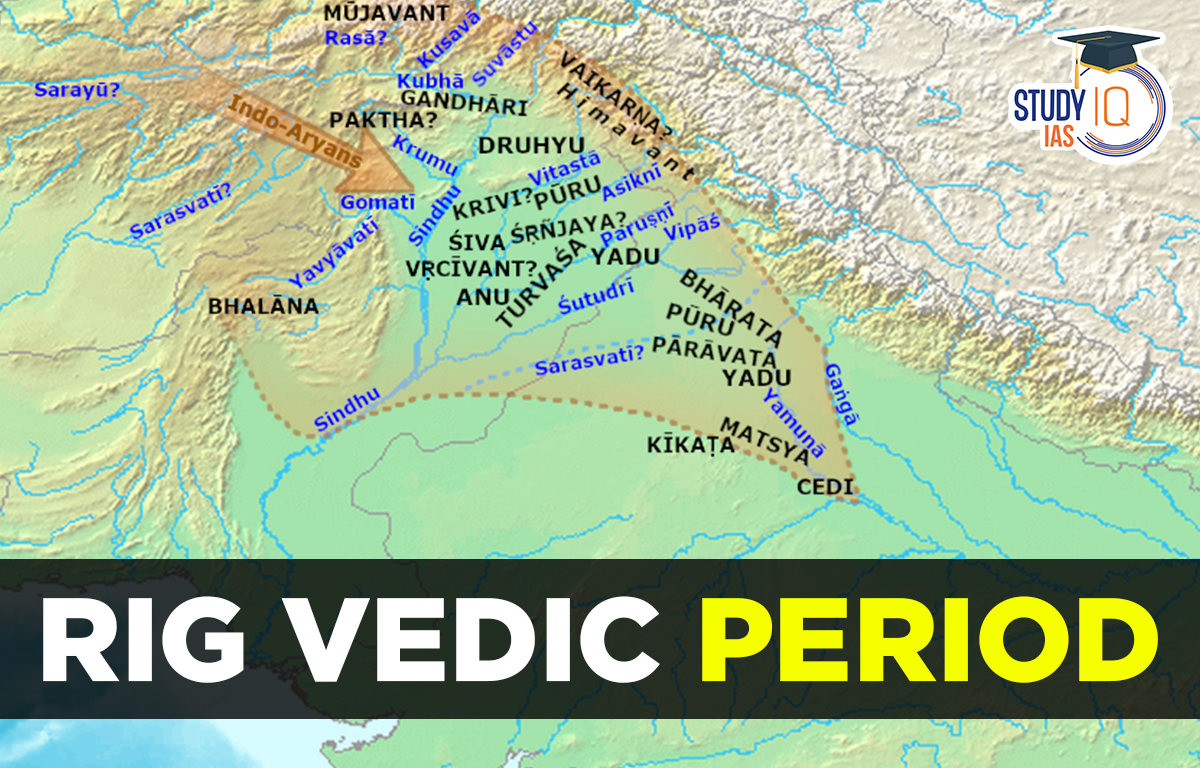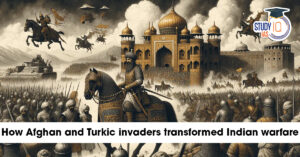Table of Contents
Rig Vedic Period
An important era in the annals of ancient India is the Rig Vedic Period. This ranges from (1500 BC – 1000). According to scholars, the Vedic culture existed between the second and first millennia B.C.E. and lasted until the sixth century. Because the Vedic literature and the Vedas were created in this age on the Indian subcontinent, it is known as the Vedic Age or Vedic Period. The Vedas were influenced by the customs and way of life that prevailed during the Vedic Period. This article has all the details related to Rig Vedic period of Ancient history one of the important section of UPSC Syllabus.
Read about: Sangam Period
Rig Vedic Period History
Ten volumes, referred to as Mandalas, make up the Rigveda. 10,600 verses and 1,028 hymns make up this compilation. In any Indo-European language, it is the earliest text. As far back as 1700 BC, it had its beginnings. 35% of songs were written by the Angiras (a rishi family), and 25% of the Rig Veda was written by the Kanva family.
Numerous verses from the Rig Veda are still incorporated into important Hindu ceremonies and prayers. It offers a wealth of information on how the world came into being, the significance of the Gods, and how to lead a fulfilling and successful existence. According to the Rig Veda, Prajapati, the original God and the fundamental cause of existence, created the universe.
The hymns, referred to as Sukta, were written to be sung during ceremonies. The main god mentioned in the Rig Veda is Indra. Along with the older Aryan deities, the Rig Veda also contained other main deities that were significant. These included the sky God Varuna, the fire god Agni, and the sun god Surya. The Rig Veda attributes Lord Shiva, a Hindu deity, to the mountain and tempest god Rudra.
According to the Rig Veda, Lord Vishnu, one of the Trimurti of Hindu gods, was once a minor divinity. The Rig-Veda also contains the eminently well-known Gayatri chant (Savitri). This hymn mentions the varna system, the four divisions of society, “Sudra,” Gamester’s Sorrow, and Purusha Shukta Hymns.
Read about: Alexander Invasion of India
Rig Vedic Period Political Structure
Rajan was the title of the government’s leader. In the Rig Vedic Period, the Jana was the biggest political and administrative entity. “Kula” was the name of the fundamental political subdivision. A “grama” is a collective term for several households. The “Gramani” was the “grama’s” leader. ‘visu’ refers to a group of communities led by a ‘vishayapati. Sabhas and Samitis were terms for tribal meetings. Tribal nations go by the names of Bharatas, Matsyas, Yadus, and Purus.
Read about: Asiatic Society
Rig Vedic Period Social Structure
Women were permitted to join in Sabhas and Samitis and held respectable positions. Women writers like Apala, Lopamudra, Viswavara, and Ghosa were among them. The importance of cows among livestock increased. Although polygamy wasn’t common, it existed among the families of aristocracy and nobility. The tradition of child marriage did not exist. Despite not being strictly observed and hereditary, social differences did exist.
Read about: Indus Valley Civilization
Rig Vedic Period Economic Structure
The majority of Aryans were pastoral and livestock farmers. They worked in farmland. Chariots and ploughs were fashioned by carpenters. Workers used iron, brass, and copper to create a vast number of items. For the creation of cotton and woollen textiles, spinning was used. Ornaments were created by goldsmiths, and different types of household vessels were created by potters. Initially, trade was carried out through the barter system, but for significant deals, gold coins known as “nishka” were used. Through waterways, transportation was conducted.
Read about: Maurya Empire
Rig Vedic Period Religion
By personifying various natural elements into gods, they practised worship of things like earth, fire, wind, rain, thunder, etc. The most significant deity was Indra (thunder). Prithvi (earth), Agni (fire), Varuna (rain), and Vayu were additional deities (wind). Ushas and Aditi were female deities. No ceremonies were observed in temples or idol worship.
Read about: Gupta Empire
Sabha and Samiti in Rig Vedic Period
Prajapati’s daughters are known to as Sabha and Samiti. Both had leaders in movable corps who moved with the army.
Sabha in Rig Vedic Age
Sabha refers to both the assembly (during the early Rig Vedic era) and the meeting space (During the later Rig Vedic period). At this gathering, there were also ladies from the Sabhavati. However, it was primarily a kin-based gathering, and until later in Vedic times, women were not permitted to participate. The Rigveda also describes the Sabha as a place for dancing, music, witchcraft, and sorcery as well as dicing and gambling. It discussed spiritual matters, carried out judicial and administrative duties, and used legal authority.
Samiti in Rig Vedic Period
Samiti is given consideration in the most recent books of the Rig-Veda, which indicates that it continued to gain importance after the Rigvedic time. Samiti was a tribal council where tribespeople met to discuss tribal matters. Both religious rituals and prayers and philosophical topics were addressed. Rajan was chosen or re-elected by the Samiti, the sources claim.
Read about: Mahajanapadas
Rig Vedic Period UPSC
The era of the Rig Veda A key component of the Ancient Indian History section of the IAS examination syllabus is UPSC. Four Vedas that provided a glimpse into the Vedic Age and its society came into being during this time. Additionally, it is a crucial subject for UPSC candidates. To succeed in the UPSC test, we counsel the candidates to be thorough with their knowledge and to write down the Vedic Age notes. To learn more about any part of history candidate can visit the official website of the StudyIQ official website Online UPSC Coaching.
Read about: Physiography of India


 Birsa Munda Birth Anniversary 2025: Life...
Birsa Munda Birth Anniversary 2025: Life...
 Military Innovations of Afghans and Turk...
Military Innovations of Afghans and Turk...
 Self-Respect Movement, History, Objectiv...
Self-Respect Movement, History, Objectiv...

























